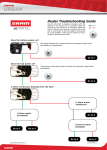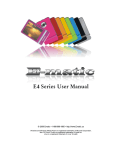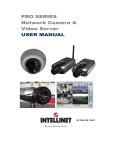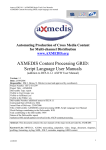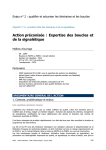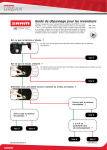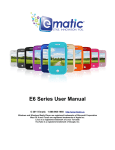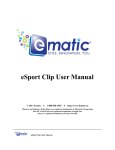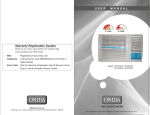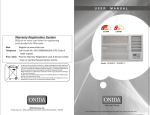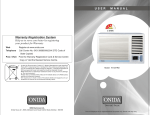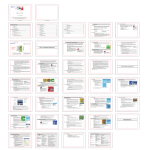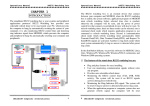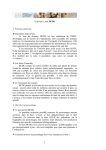Download E5 Series User Manual
Transcript
E5 Series User Manual © 2009 Ematic • 1-888-968-1985 • http://www.Ematic.us Windows and Windows Media Player are registered trademarks of Microsoft Corporation. Mac OS X and iTunes are registered trademarks of Apple Inc. Linux is a registered trademark of Linus Torvalds. Table of Contents 1.0 Introduction................................................................................................................................1 1.1 Foreword.......................................................................................................................1 1.2 Package Contents........................................................................................................1 1.3 Warnings.......................................................................................................................1 1.4 Computer Requirements...............................................................................................1 1.5 Layout of the Player......................................................................................................2 Part I: Computer Operations 2.0 3.0 4.0 5.0 Connecting and Charging the Player........................................................................................4 2.1 Connecting and Disconnecting the Player from Your Computer..................................4 2.2 Charging the Battery.....................................................................................................4 Video Conversion......................................................................................................................5 3.1 Installing Video Conversion Software (Windows).........................................................5 3.2 Converting Video (Windows)........................................................................................5 3.3 Using Other Conversion Software (Windows)..............................................................6 3.4 Converting Video in Linux.............................................................................................6 Copying Files.............................................................................................................................7 4.1 Copying Media Files to your Player..............................................................................7 4.2 Using Windows Media Player's® Sync Function..........................................................8 Expanding the Player's Storage................................................................................................9 5.1 Preparing MicroSD or “TF” Cards for Use....................................................................9 Part II: Player Operations 6.0 7.0 Basic Operations.....................................................................................................................11 6.1 Turning the Player On and Off....................................................................................11 6.2 Understanding and Navigating Menus........................................................................11 6.3 Changing the Volume.................................................................................................12 6.4 Virtual Keyboard.........................................................................................................12 Watching Videos.....................................................................................................................13 7.1 Playing a Video...........................................................................................................13 7.2 Basic Play Operations................................................................................................13 E5 Series User Manual Page ii 8.0 9.0 10.0 11.0 12.0 13.0 14.0 7.3 Video Menu Commands.............................................................................................13 7.4 File Menu Commands.................................................................................................14 Listening to Audio....................................................................................................................14 8.1 Playing an Audio File..................................................................................................14 8.2 Basic Play Operations................................................................................................14 8.3 Audio Menu Commands.............................................................................................14 8.4 File Menu Commands.................................................................................................15 Viewing Pictures......................................................................................................................16 9.1 Entering My Picture Mode..........................................................................................16 9.2 Basic Play Operations................................................................................................16 9.3 My Pictures Menu Commands....................................................................................16 Shooting Photographs.............................................................................................................17 10.1 Entering Camera Mode...............................................................................................17 10.2 Basic Photo Shooting Operations...............................................................................17 10.3 Camera Menu Commands..........................................................................................17 Recording Video......................................................................................................................18 11.1 Entering DV Mode......................................................................................................18 11.2 Basic Video Shooting Operations...............................................................................18 11.3 The DV Menu..............................................................................................................19 Recording Audio......................................................................................................................19 12.1 Entering Recorder Mode.............................................................................................19 12.2 Basic Recorder Operations.........................................................................................19 E-Book Operations..................................................................................................................20 13.1 Entering E-Book Mode................................................................................................20 13.2 Basic E-Book Operations............................................................................................20 13.3 E-Book Menu..............................................................................................................21 13.4 File Operations...........................................................................................................21 Listening to the FM Radio.......................................................................................................21 14.1 Basic Radio Operations..............................................................................................21 14.2 FM Radio Menu .........................................................................................................22 14.3 Secondary Menu.........................................................................................................23 E5 Series User Manual Page iii 15.0 16.0 Tools ....................................................................................................................................23 15.1 Accessing the Tools....................................................................................................23 Device Settings.......................................................................................................................24 Miscellaneous 17.0 18.0 19.0 Formatting the Player..............................................................................................................27 17.1 Understanding Filesystems........................................................................................27 17.2 Reformatting Your Player in Windows........................................................................27 Help ....................................................................................................................................28 18.1 Troubleshooting..........................................................................................................28 18.2 For More Help.............................................................................................................28 Technical Specifications..........................................................................................................29 E5 Series User Manual Page iv 1.0 Introduction 1.1 Foreword Thank you for purchasing this player. Please read this manual carefully before using the product. Specifications and software updates are subject to change without notice. The player pictured in this manual may differ from yours, but the information in this manual will still apply. Please Watch the How-To Video pre-loaded on your player for more information. 1.2 Package Contents Your player comes with the following items: ● ● ● ● The player A silicone case A USB cable A cleaning cloth ● ● ● ● One pair of stereo headphones An audio/video cable This user manual A quick-start guide 1.3 Warnings ● ● ● ● ● ● ● Do not use the product in extreme temperatures, or dusty or wet environments. Do not leave the product in direct sunlight. Only insert or remove microSD/TF cards when the unit is turned off. Do not disconnect the player and USB from your computer without first ensuring a “safe removal” as this may damage the player. See pg. 4. Do not open or disassemble the player as this will void the warranty. Handle the player with care to prevent its physical damage. Protect the player from static discharge. 1.4 Computer Requirements Virtually any computer and operating system that is able to use USB storage devices can be used to copy files to and from the player. These include Windows®, Mac OS X®, and Linux®. E5 Series User Manual Page 1 of 33 The following, however, is required in order to use the included video conversion software: ● ● ● ● ● Windows 2000/ME/XP/Vista An 800MHz or faster CPU USB port CD-ROM drive At least 50MB free hard disk space 1.5 Layout of the Player E5 Series User Manual Page 2 of 33 Part I: Computer Operations E5 Series User Manual Page 3 of 33 2.0 Connecting and Charging the Player 2.1 Connecting and Disconnecting the Player from Your Computer Turn on the player and use the included USB cable to connect it to your computer. Plug the small end of the USB cable into the player, and the large end of the cable into the computer. The first time you connect the player to your computer, your computer will detect it and automatically install any necessary drivers. When it has finished, the player will appear in Windows under My Computer as Removable Disk or USB Disk Device. To safely disconnect the player from your Any USB device computer in Windows, click the green arrow that stores data in the system tray (the area by the clock on (e.g. flash drives, cameras, and your task bar), which will display a list of media players) should always attached USB devices. Click the player in the be disconnected from your list. Windows will display a message when it computer using this method! is safe to remove the player. 2.2 Charging the Battery The player has a built-in battery that must be charged before the player can be used. 1. Turn on the player. 2. Connect your player to a turned-on computer via the USB cable. Charging will be begin automatically. 3. Let the player charge for 4 hours. 4. Disconnect the player from the computer using the safe removal method on pg. 4. E5 Series User Manual Page 4 of 33 3.0 Video Conversion 3.1 Installing Video Conversion Software (Windows) Before watching videos on your new player, they must be first converted to the format recognized by the player. This conversion can be done with Windows software that came included with your player. Follow these steps to install the software: This player will only play videos that that are, or have been converted to, a compatible video format. 1. Place the included CD into your computer's disc drive. 2. Click Start > My Computer, and then click the drive corresponding to your disc drive. 3. Double-click Setup.exe to perform the installation. 4. Complete the installation as directed by the installation wizard. If Windows asks you whether to allow the installation, click ALLOW. 3.2 Converting Video (Windows) To play videos on your player, you must (a) have some videos on your computer, (b) convert them to the format supported by your player if necessary, and then (c) copy the video files to your player. Note: You cannot convert copyprotected DVDs. Follow these steps to convert video files: 1. Connect your player to your computer using the USB cable if you wish to save directly to the player. 2. Run the conversion software by clicking Start > Programs > Multimedia Player Utilities > Video Converter. 3. Choose a folder in which to save the converted files by clicking the red icon beside the Output File field. You can either save the converted files to your computer and copy them to the player later, or save them directly to the player itself. To save the converted files directly to the player, save to the player's VIDEO folder. 4. Build a list of videos to convert. Click the green icon next to the Input File field, navigate your folders, and select one or more videos to convert. (Note that the program will not convert from any video E5 Series User Manual Page 5 of 33 format.) Once a video is selected, it will be added to a file list at the bottom of the window. Repeat the Add File process until you have completed your list of videos to convert. 5. Once the list is complete, click the Begin button ( ) to start converting and saving the list of videos. A message will appear to indicate when the list is complete. 3.3 Using Other Conversion Software (Windows) While the included software converts numerous formats to the format required by the player, there may be some that it cannot convert, such as MP4 files. However, you can find other free software on the Internet that can do the job. For software that specifically converts MP4 fies, follow these steps: 1. Using your favorite web browser, visit www.download.com. 2. Enter the following search phrase: pazera mp4 avi 3. Click Download Now on the row that reads Pazera Free MP4 to AVI Converter. 4. Once the download is complete, unzip the file. 5. To run the program, enter the new unzipped folder and double-click mp4toavi.exe. 6. Run the program and make sure that when you convert videos that you configure a resolution of 320x240. 3.4 Converting Video in Linux While the player does not come with conversion software for Linux, there are several free, open source programs available in Linux that can do the necessary transcoding. The three most powerful commandline encoders are mencoder, ffmpeg., and transcode. To make things easier, you can E5 Series User Manual Xvid video encoder Filter: reduce to 320x240 MP3 audio encoder Filter: Mix audio down to stereo AVI file container Page 6 of 33 use one of the many available front-ends, although the simplest may be avidemux (pictured). Regardless of the tool you use, transcode videos as follows: ● ● ● ● ● Use AVI as the file container. Encode video using the Xvid codec. Resize video to 320 x 240 pixels or smaller. Encode the audio using an MP3 codec. Reduce the audio to 2 channels if the original was more, such as 5.1. There may be other transcoding “formulas” that will produce videos that are compatible with the player. Also note that there are some formats that will work without conversion. For a full list of supported formats, see “Technical Specifications” on pg. 29. Note: Ematic does not provide support to Linux users, however, you can get help from the Linux community on the Internet via information sites, forums, and e-mail lists. 4.0 Copying Files 4.1 Copying Media Files to your Player To listen and/or view media on your player, Make certain your you must first copy the files from your media files are computer to the player. Before copying files supported by the player. to your player, you must make certain that the files you wish to enjoy on your player are, in fact, supported by the player. See the full list of supported formats under “Technical Specifications” on pg. 29. Read about video conversion on pg. 5. Windows Follow these steps to copy media files under Windows: 1. Switch the player on. 2. Connect the player to your computer with the USB cable. 3. Open a window to the player: Double-click My Computer, and then double-click the drive that corresponds to the player. It will probably be labeled Removable Disk. E5 Series User Manual Page 7 of 33 4. Using the same process, open a window to your music, video, or other media files files. 5. Drag-and-drop media files from your computer's window to the player's window. Media files must be copied to the correct folders: Music files are copied to the MUSIC folder. You can use subfolders. Video files are copied to the VIDEO folder. Image files are copied to the PICTURES folder. E-book files are copied to the TXT folder. 6. Disconnect the player from the computer using the safe removal method on pg. 4. Mac OS X and Linux 1. Switch the player on. 2. Connect the player to your computer with the USB cable. 3. Mac OS X: Use a file manager to open a window to the player, which will appear as any other flash media. Linux: Mount the device in read/write mode and open a window to the device using the file manager of your choice. 4. Using the same process, open a window to your music, video, or other media files files. 5. Copy media files from your computer's window to the player's window. Media files must be copied to the correct folders: Music files are copied to the MUSIC folder. You can use subfolders. Video files are copied to the VIDEO folder. Image files are copied to the PICTURES folder. E-book files are copied to the TXT folder. 6. Unmount the media from your system, if necessary, so that you're certain your operating system has completed any read/write operations to the player. 7. Unplug the USB cable. 4.2 Using Windows Media Player's® Sync Function If you sync your player with Windows Media Player, follow these steps when initially syncing the device: 1. Turn the player ON. 2. Connect the player to your computer. E5 Series User Manual Page 8 of 33 3. Run Windows Media Player and then click the tiny down arrow on the Sync tab. 4. Click USB DISK DEVICE and then Set Up Sync on the submenu. 5. If you want Windows to automatically sync your player, then select Sync this device automatically, otherwise clear the box, and click Finish. 6. Highlight the files you want transferred to your device and drag them into the Sync List column. 7. Click Start Sync to transfer the files. When the process is complete, the you should be able to see the song files on the player through My Computer. Note: See the full list of supported formats under “Technical Specifications” on pg. 29 to determine which synced songs will be supported by the player. 5.0 Expanding the Player's Storage 5.1 Preparing MicroSD or “TF” Cards for Use You can expand the player's capacity by adding a MicroSD card (also known as a TransFlash or TF card) with a capacity of up to 8GB. First, however, it must be prepared for use by the player. Follow these instructions to prepare the card: 1. Turn the player off. 2. Insert a microSD/TF card into the player. 3. Turn on the player. 4. Select Setting from the Mode Selector. 5. Select Player Configure from the menu. 6. Select Format Card from the next menu. The function will create the necessary folders. 7. Use the USB cable to connect the player to your computer. 8. Access your MicroSD card through My Computer. When in Video, Camera, and other modes, you can access files on your microSD card via the Dir List menu option. E5 Series User Manual Page 9 of 33 Part II: Player Operations E5 Series User Manual Page 10 of 33 6.0 Basic Operations 6.1 Turning the Player On and Off On: To turn the player on, move the player's on/off switch to the ON position, and then hold the PLAY button until the display turns on. Off: In any working mode, hold the PLAY key, or move the player's on/off switch to the OFF position. Pay special attention to whether these instructions indicate whether to press or press and hold a button! By default, if the player is left idle for three minutes, it will turn itself off. That can be configured to turn off after a different duration, or not at all. (See “Device Settings” on pg. 24.) The unit will also turn itself off if the battery becomes too weak. 6.2 Understanding and Navigating Menus The Mode Selector The player does many things, including playing audio and video media and shooting photos or video. To enter any of these modes, call up the Mode Selector by pressing the CAMERA button. When the player is turned on, it displays the Mode Selector. Browse the modes with the arrow keys, and then select a mode with the MENU button. File List Once you have selected any review mode (My Music, My Pictures, Video Player, E-Book), a list of you files will appear. Highlight files using the arrow keys, and select a file by pressing the MENU button. Menus Whether you are still in the file list, or looking/listening to a file, you can display a menu of file and play options by holding the MENU button, or by pressing the VOL button. E5 Series User Manual Page 11 of 33 In any menu or list, you can use the arrow buttons to navigate the list, and select with a press of the MENU button. The same is true if you descend into submenus. Some options can be changed in the list without the use of a submenu. This is normally the case where a menu option has a colon and value. For example, “Replay Times: 3” can be changed in the list. Use the arrow buttons to highlight the setting, as usual, but then change the value by pressing the PLAY and MENU buttons. Sometimes the player will display a dialog box, asking you to confirm a change. Use the arrow buttons to highlight your answer and select it by pressing the PLAY button. To back up to a previous menu, press the VOL button. In all viewing/listening modes, you can return to the Mode Selector by pressing the CAMERA button. 6.3 Changing the Volume In Video Player, My Music, or Radio mode, the volume is changed as follows: 1. Hold the VOL button to enter the volume changing mode. 2. Use the arrow buttons to change the volume. 3. Press the VOL button to exit the volume changing mode, or wait a few seconds for the player itself to exit itself. 6.4 Virtual Keyboard There are some functions that require you to use a virtual keyboard to type. To use the keyboard: ● ● ● ● Move the highlighter left or right with the arrow buttons. Move the highlighter up and down with the CAMERA and MENU buttons, respectively. “Press” a virtual key with the PLAY button. Delete typed characters (like a Backspace key) with the VOL button. Once you've typed your characters, use these same keys to highlight and select the checkmark key at the bottom of the virtual keyboard. E5 Series User Manual Page 12 of 33 7.0 Watching Videos 7.1 Playing a Video This player will only play videos that are or have been converted to a compatible video format. See “Technical Specifications” on pg. 29 for a list of supported formats. See pg. 5 for conversion information. Use the Mode Selector to select the Video Player mode, and then select a video. (See “Understanding and Navigating Menus“ on pg. 11.) 7.2 Basic Play Operations ● ● ● ● Pause or resume by pressing the PLAY button. Skip to the previous or next video file by pressing the arrow buttons. Fast-forward or rewind by holding the arrow buttons. Change the volume as described on 12. 7.3 Video Menu Commands Hold the MENU button to display the black-background player menu. Navigate as described under “Understanding and Navigating Menus“ on pg. 11. Some combination of the following commands will be available, depending on whether you bring up the menu from the file list or . ● ● ● ● ● ● Remove will delete the file. Loop mode will open a sub-menu from which you can select a repeat mode. Add Tag will create a bookmark at the current timemark of the current video. You can later access the bookmark directly. Information will display statistics about the file being played. Protect File will move the file to a protected partition if you've set one up. Volume will open the volume control. E5 Series User Manual Page 13 of 33 7.4 File Menu Commands When you are viewing file list, you can access a file menu by pressing the VOL button. From this menu you to switch between the files on the Local Memory or Card Memory. If you press the VOL button again, the menu will display the following: ● ● ● Now Playing returns you to the file list. Dir List allows you to switch between different lists of files. My Video Tag List a list of bookmarks or “tags” that you created while watching videos. To go to a tag, select My Video Tag List, and then highlight and select a tag entry. To delete a tag, hold the MENU button to display the menu, and then select Remove from the menu. Press the VOL button again to return to the Mode Selector. 8.0 Listening to Audio 8.1 Playing an Audio File Use the Mode Selector to select the My Music mode, and then select a audio file to which to listen. (See “Understanding and Navigating Menus“ on pg. 11.) 8.2 Basic Play Operations ● ● ● ● ● Pause or resume by pressing the PLAY button. Skip to the previous or next file by pressing the arrow buttons. Fast-forward or rewind by holding the arrow buttons. Change the volume as described on 12. Assign up to a five-star rating by pressing the MENU button, and then using the arrow buttons to increase or decrease the rating. 8.3 Audio Menu Commands Hold the MENU button to display the black-background music, menu. Navigate as described under “Understanding and Navigating Menus“ on pg. 11. Some combination of the following commands will be available, depending on whether you bring up the menu from the file list or . E5 Series User Manual Page 14 of 33 ● ● ● ● ● ● ● ● ● ● ● ● Repeat allows you to select one of many repeat patterns. EQ Settings allows you to select one of many equalizer presets. Replay Mode activates a looping mode. Once you select this mode, the player will indicate that it is ready for you to set point A by displaying A- in the loop indicator. To set point A, press the right arrow button. The player will then indicate that you can set point B by displaying -B in the loop indicator. When you hear the point at which you want the loop to end, press the right arrow button again. The icon will then indicate that the loop is set by displaying A-B, and will then play the loop a set number of times (see Replay Times below), waiting a set number of seconds between each loop (see Replay Gap below). While the indicator reads -B, you can reset point A by pressing the left arrow button and starting the process again. Replay Times sets the number of loop repetitions. Replay Gap sets the number of seconds between each loop. Tempo Rate allows you to increase the speed of play. Remove will delete the file. Add to MyList will add the song to one of five personal playlists. Information display statistics and ID tags for the audio file. Add Tag adds a bookmark at that place in the song. Fade In/Fade Out sets whether songs will fade in and out when playing is started or stopped. Volume will open the volume control. 8.4 File Menu Commands When you are viewing the file list, the files are listed by file name. If you press the VOL button you can select alternate ways to list your audio files: ● ● ● ● ● ● ● ● All Music lists all your songs by filename. Artist lists the artists of your songs. Select an artist to listen to all the songs by that artist. Album lists all the albums represented by your music collection. Select an album to listen to all the songs from that album. Genre lists songs based on their genre ID3 tag. Select a genre to listen to all your songs that are tagged with that genre. My Music List lists the five playlists you created. Dir List allows you to switch between files stored in internal memory, and those stored on your microSD card (if you're using one). Record List lists all the audio you created with the player in Record mode. My Music Tag List displays a list of bookmarks or tags that you created while listening to audio. To go to a bookmark, select this option E5 Series User Manual Page 15 of 33 ● and then highlight and select an entry. To delete a tag, hold the MENU button to display the menu, and select Remove. Level allows you to select songs based on ratings you assigned to songs. Select a rating (or “unclassified”) to listen to all the songs with that rating. Press the VOL button again to return to the Mode Selector. 9.0 Viewing Pictures 9.1 Entering My Picture Mode Use the Mode Selector to enter My Picture mode, and then select a photo from among the thumbnails. (See “Understanding and Navigating Menus“ on pg. 11.) 9.2 Basic Play Operations While viewing a photo ● ● ● Skip to the previous or next photo file by pressing the arrow buttons. View a status bar by pressing the MENU button. Return to the thumbnails by pressing the VOL button. 9.3 My Pictures Menu Commands Hold the MENU button to display the photo menu. Navigate as described under “Understanding and Navigating Menus“ on pg. 11. Some combination of the following commands will be available, depending on whether you bring up the menu from the file list or while viewing a photo: ● ● ● Remove will delete the file. Rotate allows you to rotate the image for display. It does not permanently rotate the image file. Zoom allows you to zoom in or out of an image. Once zoomed in, you can scroll around the image: scroll left and right with the arrow buttons; scroll up and down with the CAMERA and PLAY buttons respectively. E5 Series User Manual Page 16 of 33 ● ● ● ● Information display statistics about the photo file. Set as Startup will display the current image when the player boots. Set as Shutdown will display the current image when the player shuts down. File Protect will move the image to the protected partition, if you've set one up. 10.0 Shooting Photographs 10.1 Entering Camera Mode Use the Mode Selector to select the Camera mode. (See “Understanding and Navigating Menus“ on pg. 11.) 10.2 Basic Photo Shooting Operations Use the display as a viewfinder. Optionally zoom in and out with the arrow buttons. (The zoom is digital rather than optical.) Snap a photo by pressing the CAMERA button. Once you've taken one or more photos, press the VOL button to return to the Mode Selector. To view your photos, enter My Pictures mode where you'll find your photos in the CAMERA folder. 10.3 Camera Menu Commands Hold the MENU button to display the Camera menu. The camera displays a preview of settings that affect image quality. For instance, when you select Brightness from the menu, the viewfinder will appear, and the setting's options will appear at the bottom of the image. Select an option with the arrow keys, viewing the effect it will have on subsequent photos, and then press the VOL button to return to the menu. E5 Series User Manual Page 17 of 33 The following settings will be available: ● ● ● ● ● ● ● ● ● ● White Balance sets the white balance for photos taken indoors or outdoors. Select Auto to let the camera set the best option automatically. This setting displays a preview of options. Brightness allows you to darken or lighten subsequent photos on a scale of (-3) to +3. This setting displays a preview of options. Exposure Mode sets the exposure for bright outdoor photos or darker indoor photos. Select Auto to let the camera set the best option automatically. This setting displays a preview of options. Special Effect allows you optionally set one of three special effects: negative, sepia (to give photos that “old fashion” look), and black and white. This setting displays a preview of options. Save Path allows you to choose whether to save photos to internal memory or the microSD card (if you are using one). Resolution allows you to select one of many resolutions. Higher resolution photos produce higher quality images, but take up more storage space. Free Space displays the available storage space of the configured Save Path. Self-timer allows you to optionally set a delay of 5-20 seconds between the time the shutter button is pressed and the camera actually takes the photograph. Shutter Sound allows you to select one of three shutter sound effects that are played when you press the shutter button. You can also disable the shutter sound. Date Stamp sets whether a red-lettered date stamp is superimposed on the bottom-right corner of subsequent photographs. If so, you can choose whether the stamp includes the date and time, or just the date. 11.0 Recording Video 11.1 Entering DV Mode Use the Mode Selector to enter DV mode. (See “Understanding and Navigating Menus“ on pg. 11.) 11.2 Basic Video Shooting Operations Use the display as a viewfinder. A status bar will appear, indicating: E5 Series User Manual Page 18 of 33 ● ● The configured resolution or the length of the current recording. Whether a recording is in progress. A red dot indicates that it is not in progress while a green dot indicates when one is. Begin recording by pressing the CAMERA button. End a recording by pressing the CAMERA button again. Your videos will be saved to the VIDEO folder. Once you've finished a recording, you can return to the Mode Selector by pressing the VOL button. To view your video recordings, enter Video Player mode where you'll find your recordings in the file list. They files are named using the digits of the date and time. If, for example, you recorded a video on January 5, 2010 at 7 seconds after 6:05pm, then the filename would be 20100105180507.avi. 11.3 The DV Menu To display the DV menu, press and hold the MENU button. The settings are the same as the those in the Camera Mode menu as described on “Camera Menu Commands” on pg. 17, except for one addition setting: Record Quality allows you to choose one of four quality presets. 12.0 Recording Audio 12.1 Entering Recorder Mode Use the Mode Selector to enter Recorder mode which will immediately display the Recorder Mode menu. 12.2 Basic Recorder Operations Set record options by selecting Rec Type from the menu. (See “Understanding and Navigating Menus“ on pg. 11. for details on navigating menus.) From the Rec Type sub-menu, you can configure whether to record in WAV format or MP3 format. WAV files are not compressed, thus they produce high fidelity recordings, but require a lot of storage space. MP3 encoding is “lossy”, so MP3 recording are not as high-fidelity as E5 Series User Manual Page 19 of 33 WAV. Nevertheless, they can sound excellent (depending on the recording bitrate) and they require significantly less storage space. After selecting a fie format, you can choose a bitrate at which to record your audio. Like high photo resolution, higher bitrates produce higher quality audio, but also require more storage space. These are the basic recording operations: ● ● ● ● To record, select Now Recording from the menu. As you record, the display will show (a) the name of the file under which the recording will be saved, (b) the elapsed time of the current recording, (c) a countdown timer that indicates how much recording time is possible, based on available storage space, and (d) a recording-in-progress indicator. To pause a recording, press the PLAY/PAUSE button. To stop recording, press the MENU button. Once the recording ends, you can create another recording by pressing the PLAY button. To return to the Recorder Menu, press the VOL button. Press VOL a second time to return to the Mode Selector. 13.0 E-Book Operations 13.1 Entering E-Book Mode Use the Mode Selector to enter My E-Book mode. Use the arrow buttons to browse the list of texts and press PLAY to select a text for viewing. 13.2 Basic E-Book Operations While viewing a text, a status bar at the top of the display will indicate what page you're viewing, and the total number of pages. It will also indicate whether the scrolling will be done done manually (“Auto Mode”) or automatically (“Auto Mode”). Scrolling is done a page at a time. You can manually scroll through a text with the arrow buttons. E5 Series User Manual Page 20 of 33 You can have the player automatically scroll through a text by pressing the MENU button. See “File Operations”, below, to change the number of seconds between each page turn. 13.3 E-Book Menu While viewing a text, press and hold the MENU button to display the E-Book menu. From the menu, you can select the following commands: ● ● ● Add Tag to create a bookmark at the current page of the text. Remove to delete the text. Skip to which allows you to more quickly advance or back up to a different position within the text. 13.4 File Operations Press the VOL button to display the file menu and its options: ● ● ● ● Now Reading returns to the file list. Dir List allows you to switch between texts stored in internal memory and those stored on your microSD card (if you're using one). Tag List will display a list of your e-book bookmarks. Select a bookmark to jump to it. To delete a tag, hold the MENU button to display the tag menu, and then select Remove. Auto Play Gap changes the number of seconds between each page turn when the reader is in automatic scrolling mode (“Auto Mode”). 14.0 Listening to the FM Radio Use the Mode Selector to enter FM mode. FM radio will only work with the headphones plugged in because they function as the antenna. 14.1 Basic Radio Operations Manual Tuning Use the arrow buttons to tune into a specific frequency. E5 Series User Manual Page 21 of 33 Volume can be changed as described under “Changing the Volume” on pg. 12. You can mute the radio by pressing the PLAY button. Press PLAY again to unmute the radio. If radio stations have already been saved as presets, you can list them by pressing the MENU button. To listen to a preset, highlight and select an entry. (See “Understanding and Navigating Menus” on pg. 11.) Return to the Mode Selector by pressing the CAMERA button. 14.2 FM Radio Menu While listening to the radio, press and hold the MENU button to display the FM radio menu. From the menu, you can select the following: Automatic Tuning causes the radio to scan all available frequencies and save all stations whose signal is strong as a preset or “channel”. Save Channel If you are listening to a station that has not been saved as a preset, then select this command to save the station as a preset or “channel”. Remove If you are listening to a station that has been saved as a preset, you can delete the preset by selecting this command. Record Quality The player can digitally record an FM broadcast directly as an MP3 file. Selecting this setting allows you to configure one of three quality levels: High quality records at 256 kbps; Medium quality records at 128 kbps; and Low quality records at 64 kbps. FM Record will digitally record the tuned FM broadcast according to the configured Record Quality. Press MENU to pause the recording. Press PLAY to stop the recording and save the audio file to the player's MUSIC folder. Once audio has been recorded, go to the Mode Selector to enter My Music mode, press the VOL button for the file menu, and select Record List for a list of your MP3-encoded FM recordings. The FM recordings will have filenames beginning with “FM”. E5 Series User Manual Page 22 of 33 14.3 Secondary Menu Pressing the VOL button to display a second menu of the following options: Listen In returns you to the play screen. Station List displays a list of your presets, just as you'd see by pressing the MENU button from the play screen. FM Band allows you to configure the radio for use in either Japan or the United States of America. Stop Playing simply turns off the radio without leaving the FM Radio mode. 15.0 Tools 15.1 Accessing the Tools Use the Mode Selector to enter the Tools mode where you can select the following: Stopwatch is a chronometer that can record lap times. To start the stopwatch, press the PLAY button. To stop, press PLAY again. To record lap times, press the right arrow button. After the last time slot has been used, the stopwatch will re-use the five time slots. Calculator is a calculator that performs basic math, and includes a memory function. Press the virtual calculator keys as described under “Virtual Keyboard” on pg. 12. Calendar is a month-at-a-view calendar. You can look at the previous month by pressing the MENU button, and the next month by pressing the PLAY button. You can highlight individual days with the arrow buttons. Some special days are identified at the top of the display. For instance, highlighting December 25 will display “Christmas Day”. E5 Series User Manual Page 23 of 33 PC Camera The device can be used as a PC camera. After selecting this tool from the menu, use the USB cable to connect the camera to your computer. In Windows the camera should appear in My Computer as USB Video Device which you can use with any webcam-capable programs. 16.0 Device Settings Use the Mode Selector to enter Settings mode. The following options are available: Information to display technical information about the player. Display brings you to a submenu with two options. Backlight determines how long it takes for the screen to display the screensaver (a clock). Screen Saver Time determines how long the screen saver will show before screen turns off. Note that the device will still be on, but the screen is turned off to save battery power. Rename playlist allows you to rename your personal music playlists. Simply select a playlist and then change the name with the virtual keyboard. (See “Virtual Keyboard” on pg. 12.) Date and Time allows you to adjust the date and time on the device. See “Understanding and Navigating Menus” on pg. 11.) You can also configure whether information is displayed on the System Bar at the top of the display. Player Configure is a submenu of further options: ● ● ● ● Owner: configure your name as the owner. (See “Virtual Keyboard” on pg. 12.) Off time: The number of seconds of inactivity before the player turns itself off. Sleep time: How many minutes of play before the player turns itself off. Format Card: formats an inserted MicroSD card, and creates the necessary subfolders. E5 Series User Manual Page 24 of 33 ● ● ● Format Memory: reformats the player's internal memory, and creates the necessary subfolders. Key-press sound: determines whether the player makes a sound whenever your press a key. TV OUT: Configures whether the device plays audio and video on itself, or sends the signals through the audio/video cable attached to the earphone jack. If you turn on TV out, you must specify NTSC or PAL. North American customers must choose NTSC. Language Select allows you to change the display language. Supported languages are listed under “Technical Specifications” on pg. 29. Encrypted Disk Setting creates a This function repassword-protected partition. The process partitions the storrequires that you select a size for the age space on the player which despartition, and then a password which you set troys all files on the device! with a virtual keyboard. (See “Virtual Keyboard“ on pg. 12.) Note that the contents of the protected partition are protected from the player, but files can still be added, deleted, and modified when accessed through a computer. Reset reboots the player. E5 Series User Manual Page 25 of 33 Miscellaneous E5 Series User Manual Page 26 of 33 17.0 Formatting the Player 17.1 Understanding Filesystems Your player is like a small hard drive of data, and like any such storage device, it has a file system. If you wish to reformat the player's file system, you may use any standard formating tools as long as it is formated with FAT32 file system. 17.2 Reformatting Your Player in Windows Follow these steps to reformat your player: 1. Connect the player to your computer via the USB cable. 2. Double-click My Computer. Find the icon representing the player, which will probably appear as Removable Disk. 3. Right-click the player's icon and select Format. 4. Make certain the file system is FAT32, otherwise the player will not work! 5. Click Start. 6. When the Warning message appears, click OK. Once started DO NOT remove the USB cable as this may damage the player! 7. Once the formatting is complete, you may access the drive through My Computer. E5 Series User Manual Page 27 of 33 18.0 Help 18.1 Troubleshooting Problem Unit will not turn on Possible Reason Weak battery Invalid operation Weak battery Unit spontaneously turns off Player connected by USB cable damaged USB, but computer USB in disabled in the BIOS does not recognize the OS does not support USB device Wire wrongly connected Any issues of the PC No sound when Volume is too low playing media Wrong audio out device Unsupported file format The file is corrupted Doesn’t save: “Save Failure” Wrong language Songs on player are not in playable list Damaged earphones Format failure Storage full Wrong save path Wrong language is configured Songs in the wrong folder Solution Recharge the battery for 4 hours Switch player off and then on again Recharge the battery for 4 hours Replace with a new cable Enable USB functionality in the BIOS Install or update the OS driver Make sure the cable is firmly connected Reboot PC Turn up the volume Set right parameter Re-encode media in a supported format Re-copy the file to the player. You may have to re-encode the file. Use different earphones Format with a FAT32 file system Delete some files from the player Double-check the destination folder Change the language in Settings Move all song files to the player's MUSIC folder, or one of its subfolders 18.2 For More Help ● ● ● ● See the FAQ page on our website for information and how-to videos: http://ematic.us/ Check the Updates section of our website. View how-to videos on our website. E-mail customer service: [email protected] You can expect a response within one or two business days. E5 Series User Manual Page 28 of 33 19.0 Technical Specifications Dimensions Display USB Memory Record MP3 and WMA CMOS Camera Supported formats WE AT EMATIC STIVE TO IMPROVE OUR PRODUCTS. PLEASE VISIT US ON THE WEB AT http://ematic.us FOR UPDATES ON SUPPORTED FORMATS TV-out framerate AV-out voltage Operating temperature Menu language 82mm x 52mm x 12.5mm (length x width x thickness) Physical dimensions 2.4” LCD QVGA Resolution 320x240 pixels USB 2.0 Internal filesystem FAT32 Expansion capacity 1GB / 2GB / 4GB / 8GB (optional) Format WAV/MP3 Length 70 Hours (128MB) Compress rate 32Kbps – 384Kbps Frequency response 20Hz – 20KHz Total harmonic distortion <0.1% Signal-to-noise ratio >85dB Audio Power 8mW – 16mW Framerate 30fps Color depth 24bit Focus 1x to 2x Images JPG, PNG, GIF, BMP, TIFF images that are uncompressed, TIFF images that are compressed via Pack Bits, CCITT Group 3 fax images, and CCITT Group 4 fax images Videos RM, RMVB, AVI, WMV, and FLV videos that have a resolution of 320x240 or smaller. Audio MP3, WAV, and unprotected WMA, OGG, FLAC, and APE. Protected WMA audio files, and M4A/M4P files (any AAC-encoded audio) from iTunes® are not supported. E-book TXT NTSC 30fps; PAL 25fps ≥1V (VPP) -5°C to 40°C English, Simplified Chinese, Tradition Chinese, Japanese, Korean, French, German, Spanish, Portuguese, Dutch, Italian. E5 Series User Manual Page 29 of 33

































